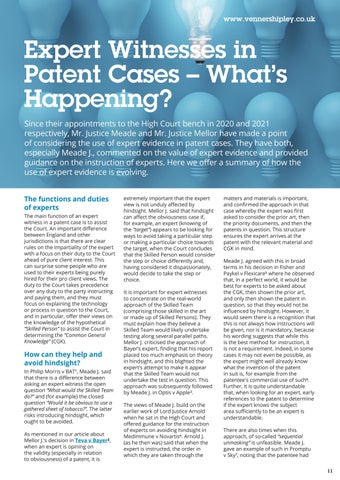www.vennershipley.co.uk
Expert Witnesses in Patent Cases – What’s Happening? Since their appointments to the High Court bench in 2020 and 2021 respectively, Mr. Justice Meade and Mr. Justice Mellor have made a point of considering the use of expert evidence in patent cases. They have both, especially Meade J., commented on the value of expert evidence and provided guidance on the instruction of experts. Here we offer a summary of how the use of expert evidence is evolving. The functions and duties of experts The main function of an expert witness in a patent case is to assist the Court. An important difference between England and other jurisdictions is that there are clear rules on the impartiality of the expert with a focus on their duty to the Court ahead of pure client interest. This can surprise some people who are used to their experts being purely hired for their pro client views. The duty to the Court takes precedence over any duty to the party instructing and paying them, and they must focus on explaining the technology or process in question to the Court, and in particular, offer their views on the knowledge of the hypothetical “Skilled Person” to assist the Court in determining the “Common General Knowledge” (CGK).
How can they help and avoid hindsight? In Philip Morris v BAT¹, Meade J. said that there is a difference between asking an expert witness the open question “What would the Skilled Team do?” and (for example) the closed question “Would it be obvious to use a gathered sheet of tobacco?”. The latter risks introducing hindsight, which ought to be avoided. As mentioned in our article about Mellor J.’s decision in Teva v Bayer², when an expert is opining on the validity (especially in relation to obviousness) of a patent, it is
extremely important that the expert view is not unduly affected by hindsight. Mellor J. said that hindsight can affect the obviousness case if, for example, an expert (knowing of the “target”) appears to be looking for ways to avoid taking a particular step or making a particular choice towards the target, when the Court concludes that the Skilled Person would consider the step or choice differently and, having considered it dispassionately, would decide to take the step or choice. It is important for expert witnesses to concentrate on the real-world approach of the Skilled Team (comprising those skilled in the art or made up of Skilled Persons). They must explain how they believe a Skilled Team would likely undertake testing along several parallel paths. Mellor J. criticised the approach of Bayer’s expert, finding that his report placed too much emphasis on theory in hindsight, and this blighted the expert’s attempt to make it appear that the Skilled Team would not undertake the test in question. This approach was subsequently followed by Meade J. in Optis v Apple³. The views of Meade J. build on the earlier work of Lord Justice Arnold when he sat in the High Court and offered guidance for the instruction of experts on avoiding hindsight in Medimmune v Novartis⁴. Arnold J. (as he then was) said that when the expert is instructed, the order in which they are taken through the
matters and materials is important, and confirmed the approach in that case whereby the expert was first asked to consider the prior art, then the priority documents, and then the patents in question. This structure ensures the expert arrives at the patent with the relevant material and CGK in mind. Meade J. agreed with this in broad terms in his decision in Fisher and Paykel v Flexicare⁵ where he observed that, in a perfect world, it would be best for experts to be asked about the CGK, then shown the prior art, and only then shown the patent in question, so that they would not be influenced by hindsight. However, it would seem there is a recognition that this is not always how instructions will be given, nor is it mandatory, because his wording suggests that while this is the best method for instruction, it is not a requirement. Indeed, in some cases it may not even be possible, as the expert might well already know what the invention of the patent in suit is, for example from the patentee's commercial use of such⁶. Further, it is quite understandable that, when looking for an expert, early references to the patent to determine if the expert knows the subject area sufficiently to be an expert is understandable. There are also times when this approach, of so-called “sequential unmasking” is unfeasible. Meade J. gave an example of such in Promptu v Sky⁷, noting that the patentee had 11












